What is perimeter?
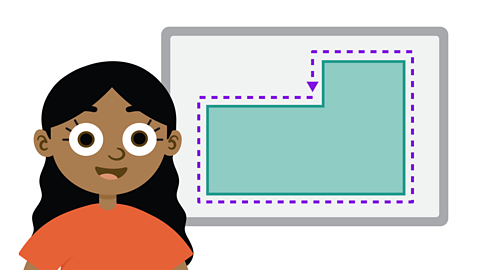
The perimeter is the distance around the outside of a closed 2D shape, space or area.
You see the perimeter in real life on a football pitch or around a house to show its boundary.
You can only find the perimeter if the shape, area or space is closed. You cannot find the perimeter of a shape if a side is open.

Quiz
Why not see how much you know about this topic already? Then complete the guide and see if you can beat your score.
What is perimeter measured in?
The perimeter can be measured in millimetres (mm), centimetres (cm), metres (m) and kilometres (km).
The unit of measure you use depends on the size of the perimeter that you want to work out.
If you are measuring the perimeter of this hexagon, you would use cm. You would not use metres because the shape is small, so it needs a smaller measure.
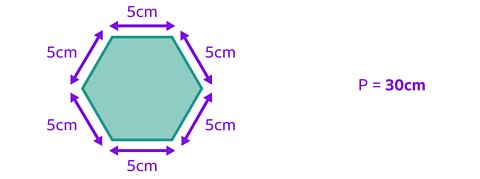
If you were measuring the perimeter of a football pitch, because it is much larger, you would use metres.
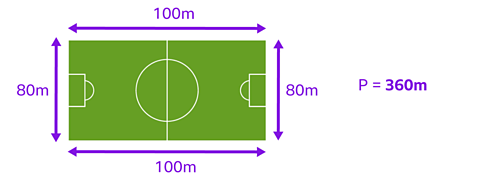
Calculating the perimeter on a grid
To calculate the perimeter, we find the total length of all the sides.
This rectangle has been drawn on centimetre squared paper, so you can count the squares to work out the lengths and widths and record the answer in centimetres.

Have you noticed the pink dot?
This is to mark the starting point. You don’t want to miss any squares out or count some more than once!
Start at the dot and move clockwise around the outside of the shape, counting the squares and labelling the sides, until you get back to the pink dot.
Next, you need to work out the total, so you add the measurements up.
5cm + 4cm + 5cm + 4cm = 18cm
The perimeter equals 18cm. You can write it like this:
P = 18cm
Calculating the perimeter of rectilinear shapes
Not all perimeters look like rectangles or shapes you recognise. However, you can find the perimeter of shapes like this in exactly the same way.
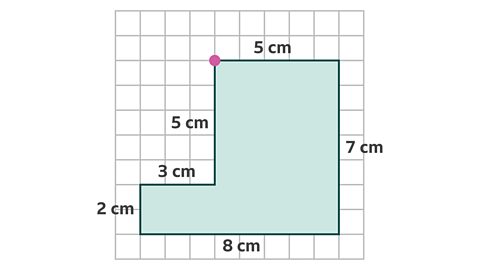
First, you place the dot, so you know where to start and finish.
Then, you count the squares along all the sides of the shape and label them.
Next, you calculate the perimeter by finding the total of all the sides.
P= 5cm + 7cm + 8cm+ 2cm + 3cm + 5cm
Before you start calculating from left to right, look to see if there are any numbers you find easy to calculate mentally.
You can see different pairs to 10, so you can use them to help calculate the perimeter.
5cm + 5cm = 10cm
7cm + 3cm = 10cm
8cm + 2cm = 10cm
You know that three lots of 10cm equals 30cm.
P = 30cm
Example 1
Here is a rectangle on a 1cm squared grid.
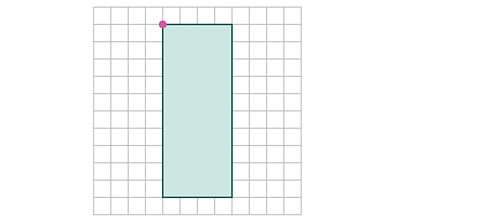
Count the squares to find the lengths and the widths of this rectangle. Then calculate the perimeter.
✓ If you count the squares you can see that the long side of the rectangle measures 10cm and the short side measures 4cm.

To calculate the perimeter you need to add these dimensions together.
You can double 10cm and then double 4cm and add the answers together.
10cm × 2 = 20cm
4cm × 2 = 8cm
20cm + 8cm
P = 28cm
You can use your knowledge of doubling, because in a rectangle there are two sets of equal length sides.
Example 2
Here is a rectilinear shape drawn on a 1cm squared grid.
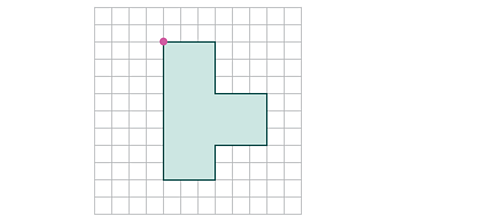
Calculate the perimeter of this shape.
✓ We need to find the total distance of all of the sides.
Count the squares to find the length of each side.
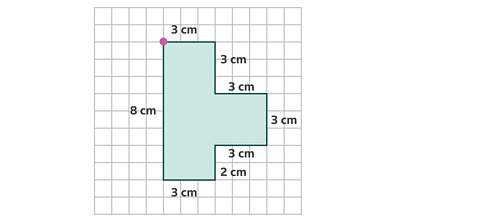
P = 3cm + 3cm + 3cm + 3cm + 3cm + 2cm + 3cm + 8cm
You can see that there are lots of 3cm length sides, so you can use your three times table to help you calculate the perimeter.
3cm × 6 = 18cm
Now you need to add the final two sides. You can see they make a pair to 10.
2cm + 8cm = 10cm
Now add these two values together to find the perimeter.
18cm + 10cm = 28cm
P = 28cm
Play Guardians: Defenders of Mathematica to get ready for SATs. gamePlay Guardians: Defenders of Mathematica to get ready for SATs.
In this game, use the times tables and more maths skills to defeat monsters and reclaim the Kingdom.

More on Length and distance
Find out more by working through a topic
- count5 of 6
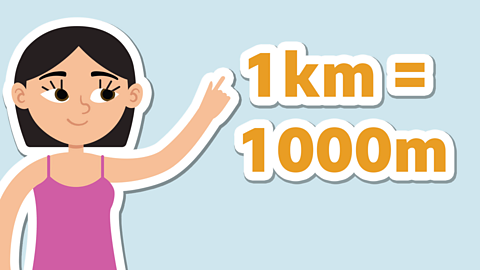
- count6 of 6

- count1 of 6

- count2 of 6
